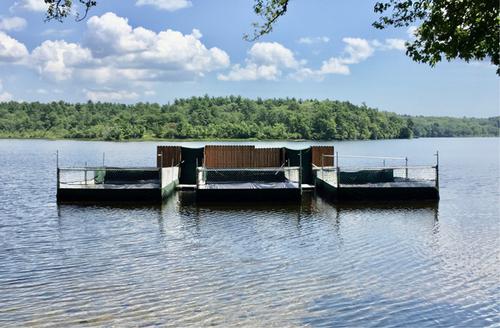Our official English website, www.x-mol.net, welcomes your
feedback! (Note: you will need to create a separate account there.)
A novel method for captive rearing and translocation of juvenile common loons
Zoo Biology ( IF 1.2 ) Pub Date : 2020-04-29 , DOI: 10.1002/zoo.21544 Michelle R Kneeland 1 , Vincent A Spagnuolo 1 , David C Evers 1 , James D Paruk 1 , Lee Attix 1 , Nina Schoch 1, 2 , Mark A Pokras 1, 3 , Virginia Stout 1 , Alex Dalton 1 , Katy Silber 1
Zoo Biology ( IF 1.2 ) Pub Date : 2020-04-29 , DOI: 10.1002/zoo.21544 Michelle R Kneeland 1 , Vincent A Spagnuolo 1 , David C Evers 1 , James D Paruk 1 , Lee Attix 1 , Nina Schoch 1, 2 , Mark A Pokras 1, 3 , Virginia Stout 1 , Alex Dalton 1 , Katy Silber 1
Affiliation

|
Common loons (Gavia immer) are diving waterbirds that are particularly challenging to keep in captivity due to their specific behavioral and physiologic needs, special housing requirements, and susceptibility to stress-related disease. We report a novel method for housing and captive rearing common loon chicks that was developed as part of the first-ever loon translocation effort in southeast Massachusetts, from 2015 to 2017. Thirteen loon chicks were reared in aquatic pens in a natural lake environment, utilizing noninvasive feeding and monitoring techniques that avoided human habituation. Chicks were reared in aquatic pens for 16-28 days before being released onto the lake. All chicks remained clinically normal and were monitored on the lake for up to 4 months following release. At least four of the chicks were subsequently confirmed to have survived to adulthood when they returned to the area in breeding plumage two to 3 years following release. Two of these confirmed adults displayed prolonged territorial pair behavior together, and this is an encouraging early sign that captive-reared individuals may form successful breeding pairs in the future. Because most immature loons remain on the ocean until at least 3 years of age, we expect additional captive-reared loons to return to the release area in subsequent years. These husbandry techniques could be applied to other loon and diving bird species that are notoriously difficult to house in captivity. The novel feeding techniques described here could also be adapted for loon chicks being reared in pools or other traditional captive settings.
中文翻译:

一种新的普通潜鸟圈养和转运新方法
普通潜鸟(Gavia immer)是潜水水鸟,由于其特定的行为和生理需求、特殊的住房要求以及对压力相关疾病的易感性,饲养起来特别具有挑战性。我们报告了 2015 年至 2017 年在马萨诸塞州东南部首次进行潜鸟易位工作的一部分,开发了一种用于饲养和圈养饲养普通潜鸟小鸡的新方法。 13 只潜鸟在天然湖泊环境中的水生围栏中饲养,利用避免人类习惯的无创喂养和监测技术。小鸡在被放回湖中之前在水族围栏里饲养了 16-28 天。所有小鸡在临床上都保持正常,并在释放后在湖中监测长达 4 个月。至少有四只雏鸟在放生后两到三年返回该地区繁殖羽毛,随后被证实存活到成年。其中两个已确认的成年人一起表现出长期的领地配对行为,这是一个令人鼓舞的早期迹象,表明圈养饲养的个体将来可能会形成成功的繁殖配对。由于大多数未成熟的潜鸟至少会在海洋上待到 3 岁,我们预计更多圈养的潜鸟会在随后几年返回放生区。这些饲养技术可以应用于其他众所周知难以圈养的潜鸟和潜水鸟类。此处描述的新型饲养技术也适用于在水池或其他传统圈养环境中饲养的潜鸟。
更新日期:2020-04-29
中文翻译:

一种新的普通潜鸟圈养和转运新方法
普通潜鸟(Gavia immer)是潜水水鸟,由于其特定的行为和生理需求、特殊的住房要求以及对压力相关疾病的易感性,饲养起来特别具有挑战性。我们报告了 2015 年至 2017 年在马萨诸塞州东南部首次进行潜鸟易位工作的一部分,开发了一种用于饲养和圈养饲养普通潜鸟小鸡的新方法。 13 只潜鸟在天然湖泊环境中的水生围栏中饲养,利用避免人类习惯的无创喂养和监测技术。小鸡在被放回湖中之前在水族围栏里饲养了 16-28 天。所有小鸡在临床上都保持正常,并在释放后在湖中监测长达 4 个月。至少有四只雏鸟在放生后两到三年返回该地区繁殖羽毛,随后被证实存活到成年。其中两个已确认的成年人一起表现出长期的领地配对行为,这是一个令人鼓舞的早期迹象,表明圈养饲养的个体将来可能会形成成功的繁殖配对。由于大多数未成熟的潜鸟至少会在海洋上待到 3 岁,我们预计更多圈养的潜鸟会在随后几年返回放生区。这些饲养技术可以应用于其他众所周知难以圈养的潜鸟和潜水鸟类。此处描述的新型饲养技术也适用于在水池或其他传统圈养环境中饲养的潜鸟。











































 京公网安备 11010802027423号
京公网安备 11010802027423号